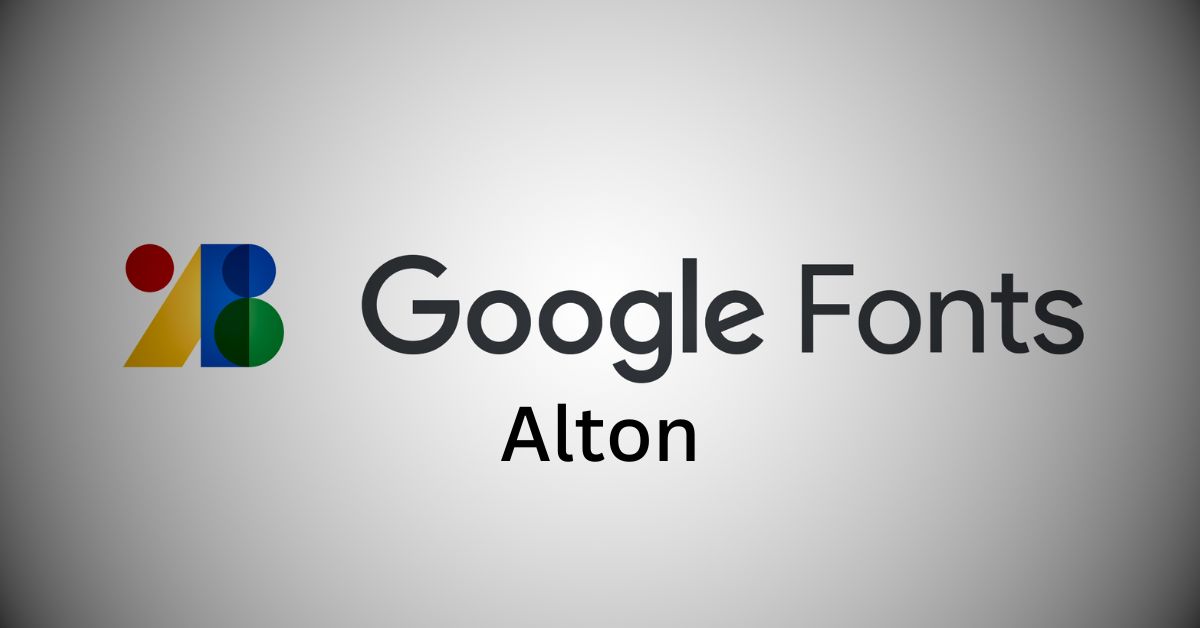
Contents
- 1 Google Fonts Alton: A Modern Classic
- 2 Understanding Google Fonts Alton
- 3 Benefits of Using Google Fonts Alton
- 4 Step-by-Step Guide to Embedding Google Fonts Alton
- 5 Troubleshooting Common Issues with Google Fonts Alton
- 6 Best Practices for Using Google Fonts Alton
- 7 Frequently Asked Questions About Google Fonts Alton
- 8 Conclusion
Google Fonts Alton: A Modern Classic
In the realm of web design, typography plays a pivotal role in shaping the overall aesthetic and user experience. Google Fonts Alton, with its elegant design and versatility, has emerged as a popular choice for designers seeking to enhance their projects. In this comprehensive guide, we will delve into the intricacies of embedding Google Fonts Alton, providing a clear and concise roadmap for incorporating this stunning typeface into your website.
Understanding Google Fonts Alton
Google Fonts Alton is a versatile sans-serif typeface renowned for its clean, geometric design and modern aesthetic. Its balanced proportions and subtle curves make it a popular choice among web designers and developers seeking to enhance the visual appeal of their projects.
Key features of Alton include:
- Geometric structure: The font’s design is based on geometric shapes, resulting in a clean and consistent appearance.
- Moderate contrast: The contrast between thick and thin strokes is moderate, providing a balanced and legible typeface.
- Wide range of weights: Alton is available in various weights, from light to bold, allowing you to adapt it to different design contexts.
- Multilingual support: The font supports a wide range of languages, making it suitable for international projects.
Alton is well-suited for a variety of design applications, including:
- Websites: Use Alton for headings, body text, and other typographic elements to create a modern and professional look.
- Applications: Incorporate Alton into user interfaces to enhance readability and visual appeal.
- Branding materials: Use Alton for logos, business cards, and other branding elements to convey a sense of sophistication and modernity.
Benefits of Using Google Fonts Alton
Aesthetic Appeal
Google Fonts Alton’s clean, geometric design and modern aesthetic make it a visually appealing choice for a wide range of projects. Its versatility allows it to complement various design styles, from minimalist to bold and expressive.
Performance Optimization
Using Google Fonts can significantly improve your website’s loading times. By hosting the font files on Google’s servers, you can reduce the number of HTTP requests and improve overall performance. This is particularly important in today’s fast-paced digital landscape, where users expect websites to load quickly.
Cross-Browser Compatibility
Google Fonts are designed to be highly compatible with different web browsers, ensuring that your website looks consistent across various devices and platforms. This reduces the need for additional font embedding methods and simplifies the development process.
Accessibility
Google Fonts Alton is designed with accessibility in mind. Its clear and legible design, coupled with its availability in various weights, makes it suitable for users with visual impairments. By using Alton, you can help ensure that your website is accessible to a wider audience.
Step-by-Step Guide to Embedding Google Fonts Alton
Adding the Google Fonts Link
To use Google Fonts Alton on your website, you’ll need to add a link to the Google Fonts library in the <head> section of your HTML document. Here’s how:
HTML
<head>
<link href="https://fonts.googleapis.com/css?family=Alton" rel="stylesheet">
</head>
Use code with caution.
Selecting the Font
You can customize the font by specifying its weight, style, and other properties within the href attribute. For example, to use the regular weight of Alton, you would write:
HTML
<link href="https://fonts.googleapis.com/css?family=Alton:regular" rel="stylesheet">
Use code with caution.
To use the bold weight, you would write:
HTML
<link href="https://fonts.googleapis.com/css?family=Alton:bold" rel="stylesheet">
Use code with caution.
Applying the Font to Your Website
Once you’ve added the Google Fonts link, you can apply Alton to specific elements of your website using CSS. For example, to apply Alton to all headings, you would use the following CSS code:
CSS
h1, h2, h3, h4, h5, h6 {
font-family: 'Alton', sans-serif;
}
Use code with caution.
To apply Alton to paragraphs, you would use:
CSS
p {
font-family: 'Alton', sans-serif;
}
Use code with caution.
You can customize the font further by adjusting its size, color, line height, and other properties using CSS.
Troubleshooting Common Issues with Google Fonts Alton
While Google Fonts Alton is generally reliable, you may encounter certain issues during the embedding process. Here are some common problems and their solutions:
Font Not Loading
- Check the link: Ensure that the link to the Google Fonts library is correct and included in the <head> section of your HTML document.
- Verify font availability: Confirm that the specific weight or style of Alton you’re using is available in the Google Fonts library.
- Inspect the console: Use your browser’s developer tools to check for any errors in the console that might be preventing the font from loading.
Font Appearing Different on Different Devices
- Browser compatibility: Ensure that your website is compatible with different web browsers and devices. Test your website on various platforms to identify any inconsistencies.
- Font rendering differences: Different devices and browsers may render fonts slightly differently. Consider using font smoothing techniques or adjusting CSS properties to improve consistency.
Font Rendering Problems
- Font stacking: If multiple fonts are defined, ensure that Alton is listed first in the font stack to prioritize its use.
- CSS conflicts: Check for any conflicting CSS rules that might be affecting the font’s rendering.
- Font weight and style: Verify that the specified font weight and style are available in the Google Fonts library.
By following these troubleshooting tips, you can effectively address common issues and ensure that Google Fonts Alton is displayed correctly on your website.
Best Practices for Using Google Fonts Alton
To maximize the potential of Google Fonts Alton in your web design projects, consider the following best practices:
Font Pairing
- Complementary fonts: Pair Alton with fonts that complement its geometric structure and modern aesthetic. Consider fonts like Montserrat, Roboto, or Open Sans for harmonious combinations.
- Contrast and balance: Create visual interest by combining Alton with fonts that offer contrasting characteristics, such as serif fonts or handwritten scripts.
Font Usage in Different Contexts
- Headings: Use Alton for headings to create a strong and impactful visual hierarchy.
- Body text: Consider using Alton for body text to enhance readability and maintain a consistent look throughout your website.
- Labels and buttons: Employ Alton for labels and buttons to improve user experience and create a cohesive interface.
Performance Optimization Tips
- Font subset: Use the subset parameter in the Google Fonts link to specify the characters you need, reducing the file size and improving loading times.
- Local font hosting: If you’re using Alton frequently, consider hosting it locally to eliminate the need for external requests.
- Font preloading: Preload the font using the <link rel=”preload”> tag to improve initial page load times.
By following these best practices, you can effectively leverage Google Fonts Alton to create visually appealing, performant, and accessible websites.
Frequently Asked Questions About Google Fonts Alton
Can I use Google Fonts Alton for commercial projects?
Yes, you can use Google Fonts Alton for both personal and commercial projects. Google Fonts is a free library of fonts that can be used in your website designs, applications, and other projects.
Is there a cost associated with using Google Fonts?
No, there is no cost associated with using Google Fonts. The fonts are freely available for anyone to use.
How can I change the color of Google Fonts Alton?
You can change the color of Google Fonts Alton using CSS. By applying a different color value to the font element, you can customize the appearance of the text.
Are there any limitations to using Google Fonts Alton?
There are generally no limitations to using Google Fonts Alton. However, it’s important to follow Google’s usage guidelines to ensure proper attribution and avoid misuse. Additionally, some fonts may have specific licensing terms or restrictions, so it’s always a good idea to check the font’s documentation before using it.
Conclusion
In this comprehensive guide, we have explored the intricacies of Google Fonts Alton, a versatile and visually appealing typeface that can elevate your web design projects. From its geometric structure and modern aesthetic to its compatibility and performance benefits, Alton offers a valuable asset for designers seeking to create engaging and impactful websites.
By understanding the key characteristics, benefits, and best practices for using Alton, you can effectively incorporate this font into your design projects and create visually stunning, user-friendly websites that leave a lasting impression.



